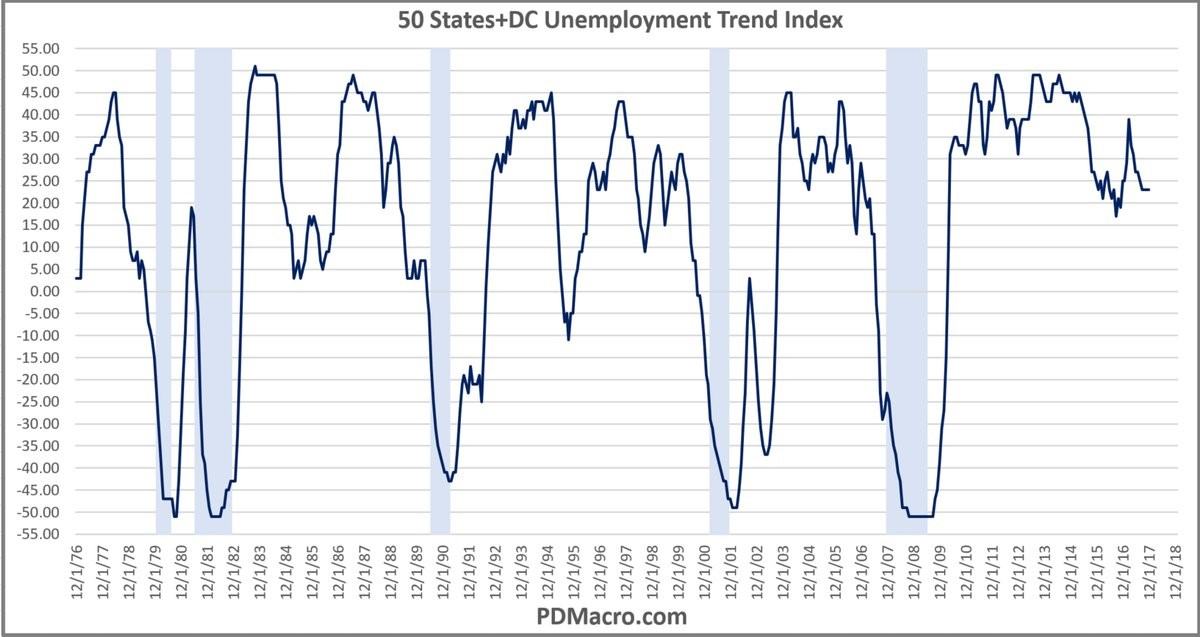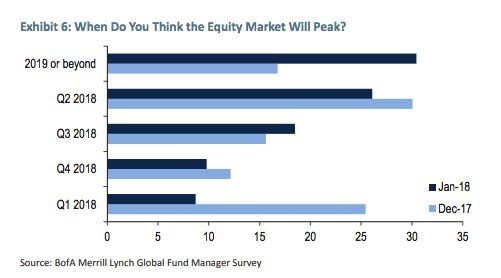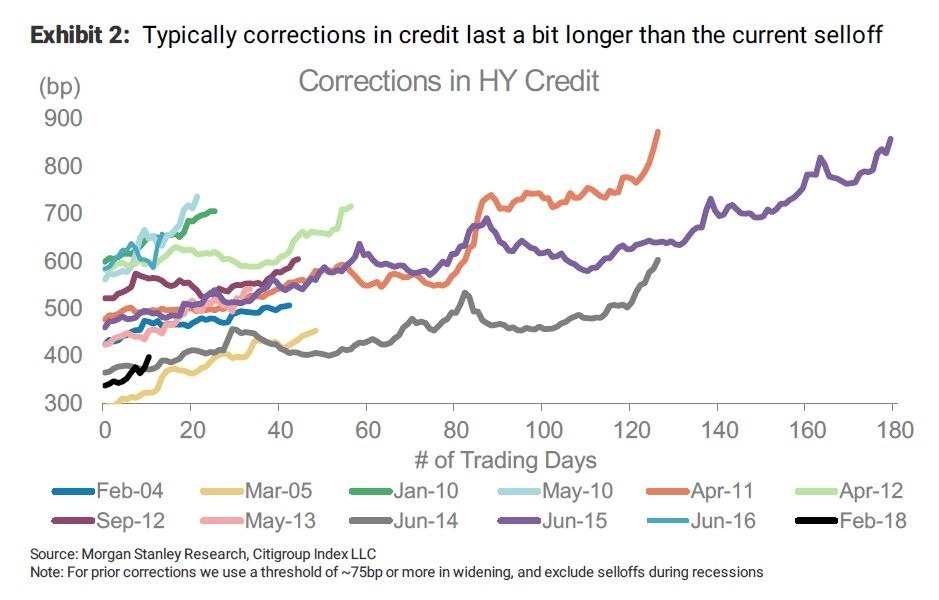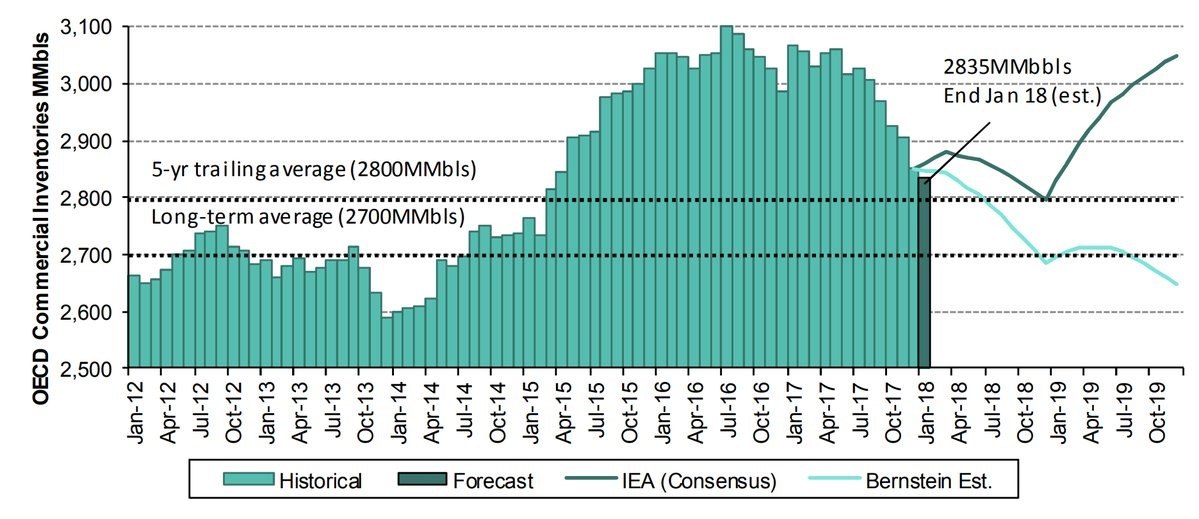Declining Labor Momentum
The chart below shows the net number of states with increasing or decreasing unemployment rates. This is like a breadth indicator for the labor market. As you can see, there are about 23 more states with decreasing unemployment rates than increasing rates. The number likely declined because of the weakness in energy from 2014-2016. It’s tough for the overall unemployment rate to go much lower since the labor market is near full employment. I’m very interested in what happens to the unemployment rate in the next 12 months because usually when unemployment increases year over year, it means a recession is afoot. That’s why it’s one of Jeffrey Gundlach’s favorite indicators. That will be tested because a few tenths of a percentage point increase shouldn’t necessarily mean the economy is about to fall off a cliff. The chart indicates that there have been many scenarios where the labor market breadth has been weak yet there was no recession.
The other indicator which is in the same situation is the Shiller PE. Stocks usually fall into a bear market when the Shiller PE falls year over year especially when it’s high. Next year might be an exception to that trend because 2008 earnings are about to come out of the trailing 10 year calculation. This will lower the multiple. Since there has only been one cycle which lasted 10 years, this scenario hasn’t happened much. The 2008 earnings were also particularly weak for a recession, making this expected decline unique.

When Will The Market Peak?
The chart below is a lesson in psychology. As you can see, Merrill Lynch asked fund managers in December and January when the stock market would peak. The percentage saying the market would peak in Q1 2018 fell by about 15% in one month. Two reasons for this are that Q1 2018 went from being the future to the present and that the sentiment improved. January saw a euphoric investor base, making few willing to stick their neck out and claim the market would crash. It’s easy to say stocks will peak at some point in the future, but it’s difficult to claim the current moment is the time it will peak.
The other reason investors don’t think the market will peak is because of the tax cut. This probably put off a recession by 1-2 years. It’s unusual to see a stimulus at this point in the cycle, so there’s little precedent for such an action. I think there’s a reasonable case to be made that the recession will be worse because of this. If you believe recessions are healthy forms of deleveraging, then a delayed recession means there is more time for toxic debt to be taken out. It’s usually difficult to see which debt is the most vulnerable, but I think covenant lite loans might be at risk. I’m also interested to see if cov-lite loans become less popular with interest rates rising.

Correction In High Yield Debt
As I mentioned in a previous article, high yield credit doesn’t always need to sell off sharply when the stock market sells off. Looking at the sell off in a different way, the chart below shows the length of previous corrections in high yield debt. This shows that the February 2018 correction has been much shorter than the other ones. This is unusual, but it doesn’t appear like the market cares about history. Since the peak, the options adjusted spread has fallen from 3.82% to 3.57%. Unless there is a selloff next week, I’d say this correction is over. So much for rising rates causing a problem for high yield credit.

The Oil Market Is Becoming Balanced
Oil increased 4.2% this week, breaking the two week losing streak. It followed stocks higher as the risk on trade was in place. Oil went up and the dollar went down. The DXY index fell 1.85 points from February 9th to the 15th. It closed the week at $89.08. Oil increased on Friday because the UAE energy minister said Saudi Arabia and Russia aim to form a long term production agreement by the end of the year when the current agreement ends. OPEC and non-OPEC countries are cutting production by 1.8 million barrels per day this year. The demand is increasing from India as the country expects to see a rebound in growth this year after last year was hurt by Modi’s demonetization efforts. U.S. production is exploding. It hit a record 10.27 million barrels per day in the past week.
The chart below supports the point the Russian oil minister made last week. He wanted to end production cuts because the oil market is in balance. As you can see, the oil inventories have fallen since 2016 which means they are coming close to the 5 year average. The oil market did a great job of predicting the glut since the price of the commodity started falling in late 2014 when the inventories were only slightly higher than the long term average. Oil started rallying in early 2016 which was around when the oil inventories peaked, but far before they started to fall. The recent acceleration in prices has worked in tandem with the decline in inventories. I am bullish on oil in the next 12 months as global growth particularly in India accelerates. The IEA and Bernstein estimates seem to agree with me. There’s a sharp divergence in their projections in 2019. The IEA may need to change that estimate if Russia and Saudi Arabia broker an extended agreement.

Conclusion
A strong oil market and continued weakness in the dollar keep the current trends in play. It means stocks will do well, especially emerging markets. The biggest risk to U.S. stocks in the next month is if the Fed raises rates 50 basis points. Since core inflation is still below the Fed’s target, I think two hikes would be an overreaction. That being said, we don’t know what the Powell led Fed thinks. The recent acceleration in inflation makes me think this meeting has a higher chance of 2 hikes than previous years.
Don Kaufman: Trade small and Live to trade another day at Theotrade.
Neither TheoTrade or any of its officers, directors, employees, other personnel, representatives, agents or independent contractors is, in such capacities, a licensed financial adviser, registered investment adviser, registered broker-dealer or FINRA|SIPC|NFA-member firm. TheoTrade does not provide investment or financial advice or make investment recommendations. TheoTrade is not in the business of transacting trades, nor does TheoTrade agree to direct your brokerage accounts or give trading advice tailored to your particular situation. Nothing contained in our content constitutes a solicitation, recommendation, promotion, or endorsement of any particular security, other investment product, transaction or investment.
Trading Futures, Options on Futures, and retail off-exchange foreign currency transactions involves substantial risk of loss and is not suitable for all investors. You should carefully consider whether trading is suitable for you in light of your circumstances, knowledge, and financial resources. You may lose all or more of your initial investment. Opinions, market data, and recommendations are subject to change at any time. Past Performance is not necessarily indicative of future results
Recommended Content
Editors’ Picks
AUD/USD jumps above 0.6500 after hot Australian CPI data

AUD/USD extended gains and recaptured 0.6500 in Asian trading, following the release of hotter-than-expected Australian inflation data. The Australian CPI rose 1% in QoQ in Q1 against 0.8% forecast, providing extra legs to the Australian Dollar upside.
USD/JPY hangs near 34-year high at 154.88 as intervention risks loom

USD/JPY is sitting at a multi-decade high of 154.88 reached on Tuesday. Traders refrain from placing fresh bets on the pair as Japan's FX intervention risks loom. Broad US Dollar weakness also caps the upside in the major. US Durable Goods data are next on tap.
Gold price cautious despite weaker US Dollar and falling US yields

Gold retreats modestly after failing to sustain gains despite fall in US Treasury yields, weaker US Dollar. XAU/USD struggles to capitalize following release of weaker-than-expected S&P Global PMIs, fueling speculation about potential Fed rate cuts.
Crypto community reacts as BRICS considers launching stablecoin for international trade settlement

BRICS is intensifying efforts to reduce its reliance on the US dollar after plans for its stablecoin effort surfaced online on Tuesday. Most people expect the stablecoin to be backed by gold, considering BRICS nations have been accumulating large holdings of the commodity.
US versus the Eurozone: Inflation divergence causes monetary desynchronization

Historically there is a very close correlation between changes in US Treasury yields and German Bund yields. This is relevant at the current juncture, considering that the recent hawkish twist in the tone of the Fed might continue to push US long-term interest rates higher and put upward pressure on bond yields in the Eurozone.